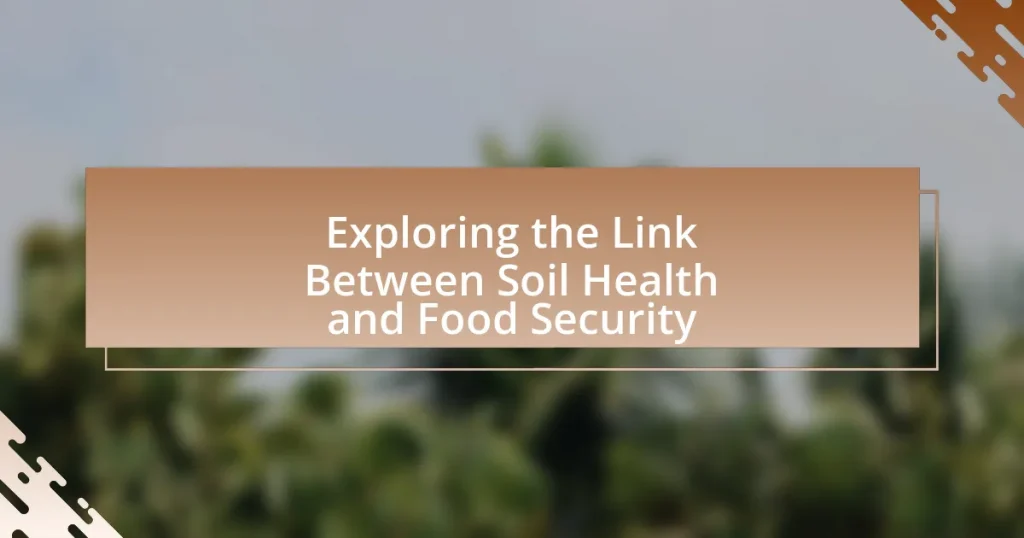The article explores the critical relationship between soil health and food security, emphasizing how soil quality directly affects agricultural productivity and crop nutritional value. It outlines key indicators of soil health, such as organic matter content, nutrient availability, and microbial activity, and discusses the impact of soil degradation on food production. Additionally, the article highlights sustainable agricultural practices, including crop rotation and cover cropping, that can enhance soil health and, consequently, food security. It also examines the role of environmental factors and government policies in promoting soil conservation and sustainable land management.

What is the relationship between soil health and food security?
Soil health directly influences food security by determining agricultural productivity and the nutritional quality of crops. Healthy soils enhance water retention, nutrient availability, and biodiversity, which are essential for growing resilient food systems. Research indicates that degraded soils can lead to reduced crop yields; for instance, the Food and Agriculture Organization (FAO) reports that soil degradation affects 33% of the world’s land, threatening food production and security. Thus, maintaining soil health is crucial for ensuring a stable and sufficient food supply.
How does soil health impact agricultural productivity?
Soil health directly impacts agricultural productivity by influencing crop yield, nutrient availability, and resilience to pests and diseases. Healthy soil enhances the structure, fertility, and biological activity necessary for optimal plant growth. For instance, research indicates that soils with high organic matter can increase crop yields by 20-30% due to improved water retention and nutrient supply. Additionally, healthy soils support diverse microbial communities that contribute to nutrient cycling, which is essential for sustainable agriculture. Therefore, maintaining soil health is crucial for maximizing agricultural output and ensuring food security.
What are the key indicators of soil health?
The key indicators of soil health include soil organic matter, soil structure, nutrient availability, microbial activity, and pH levels. Soil organic matter is crucial as it enhances water retention and nutrient supply, with healthy soils typically containing 3-5% organic matter. Soil structure affects aeration and root penetration; well-structured soils promote better plant growth. Nutrient availability, particularly nitrogen, phosphorus, and potassium, is essential for plant health, and soil tests can quantify these nutrients. Microbial activity indicates biological health, with diverse microbial communities contributing to nutrient cycling and disease suppression. Lastly, pH levels influence nutrient solubility and microbial activity, with most crops thriving in a pH range of 6.0 to 7.5. These indicators collectively provide a comprehensive assessment of soil health, directly impacting agricultural productivity and food security.
How do soil nutrients affect crop yields?
Soil nutrients directly influence crop yields by providing essential elements required for plant growth and development. Nutrients such as nitrogen, phosphorus, and potassium are critical for processes like photosynthesis, root development, and overall plant health. For instance, a study published in the journal “Agronomy” found that adequate nitrogen levels can increase corn yields by up to 50%, demonstrating the significant impact of nutrient availability on agricultural productivity.
Why is soil health critical for sustainable food systems?
Soil health is critical for sustainable food systems because it directly influences crop productivity, nutrient cycling, and ecosystem resilience. Healthy soil supports the growth of plants by providing essential nutrients, improving water retention, and fostering beneficial microbial communities. Research indicates that degraded soil can lead to a 50% reduction in crop yields, highlighting the importance of maintaining soil quality for food security. Furthermore, healthy soils contribute to carbon sequestration, which mitigates climate change impacts, thereby ensuring long-term agricultural sustainability.
What role does soil play in ecosystem services?
Soil plays a critical role in ecosystem services by providing essential functions such as nutrient cycling, water filtration, and habitat for biodiversity. These functions support plant growth, which is vital for food production and overall ecosystem health. For instance, healthy soil contributes to the availability of nutrients like nitrogen and phosphorus, which are necessary for crop yields. According to the Food and Agriculture Organization, soil degradation can lead to a decline in agricultural productivity, affecting food security for millions globally. Thus, maintaining soil health is fundamental for sustaining ecosystem services that directly impact food security.
How does soil degradation threaten food security?
Soil degradation threatens food security by reducing the land’s productivity and nutrient availability, which directly impacts crop yields. When soil quality declines due to erosion, compaction, or contamination, it leads to diminished agricultural output. For instance, the Food and Agriculture Organization (FAO) estimates that soil degradation affects about 33% of the world’s land, resulting in a potential loss of 10% to 50% of crop yields in severely degraded areas. This decline in agricultural productivity can lead to food shortages, increased prices, and heightened vulnerability for populations reliant on agriculture for their livelihoods.

What are the main factors influencing soil health?
The main factors influencing soil health include soil composition, organic matter content, microbial activity, pH levels, and moisture retention. Soil composition, which consists of minerals, organic matter, water, and air, directly affects nutrient availability and soil structure. Organic matter enhances soil fertility and supports microbial life, which is crucial for nutrient cycling. Microbial activity is vital for breaking down organic materials and facilitating nutrient uptake by plants. Soil pH influences nutrient solubility and availability; for instance, most nutrients are optimally available at a pH of 6 to 7. Moisture retention is essential for sustaining plant growth and microbial processes, with healthy soils typically having good structure to retain water while allowing drainage. These factors collectively determine soil health, impacting agricultural productivity and food security.
How do agricultural practices affect soil health?
Agricultural practices significantly affect soil health by influencing its structure, nutrient content, and biological activity. Practices such as crop rotation, cover cropping, and reduced tillage enhance soil organic matter, improve soil structure, and promote beneficial microbial communities. Conversely, excessive use of chemical fertilizers and pesticides can lead to soil degradation, nutrient depletion, and reduced biodiversity. Research indicates that sustainable agricultural practices can increase soil carbon sequestration, with studies showing that organic farming can enhance soil health indicators by up to 30% compared to conventional methods.
What are the impacts of chemical fertilizers on soil quality?
Chemical fertilizers negatively impact soil quality by disrupting its natural composition and microbial activity. The excessive use of these fertilizers leads to soil acidification, nutrient imbalances, and a decline in organic matter. Studies indicate that continuous application of chemical fertilizers can reduce soil biodiversity, which is essential for maintaining soil health and fertility. For instance, research published in the journal “Agriculture, Ecosystems & Environment” highlights that long-term reliance on chemical fertilizers can diminish soil structure and reduce its ability to retain water and nutrients, ultimately affecting crop yields and food security.
How does crop rotation contribute to soil health?
Crop rotation enhances soil health by improving nutrient availability, reducing soil erosion, and promoting biodiversity. By alternating different crops, farmers can prevent nutrient depletion that occurs when the same crop is grown repeatedly, as different plants have varying nutrient requirements and contribute different organic matter to the soil. For instance, legumes fix nitrogen in the soil, enriching it for subsequent crops. Additionally, crop rotation disrupts pest and disease cycles, reducing the need for chemical inputs and fostering a more resilient ecosystem. Research indicates that fields with diverse crop rotations can yield up to 20% more than monoculture systems, demonstrating the tangible benefits of this practice on soil health.
What environmental factors influence soil health?
Soil health is influenced by several environmental factors, including climate, vegetation, topography, and land use practices. Climate affects soil moisture and temperature, which are critical for microbial activity and nutrient cycling. Vegetation contributes organic matter and influences soil structure, while topography can affect drainage and erosion rates. Land use practices, such as agriculture and deforestation, can lead to soil degradation through compaction, erosion, and loss of organic matter. Research indicates that healthy soils are essential for sustainable food production, as they enhance crop yields and resilience to climate change.
How does climate change affect soil properties?
Climate change significantly affects soil properties by altering moisture levels, temperature, and organic matter content. Increased temperatures can lead to accelerated decomposition of organic matter, reducing soil fertility and affecting nutrient availability. Additionally, changes in precipitation patterns can result in soil erosion, compaction, and altered pH levels, which further degrade soil health. Research indicates that regions experiencing extreme weather events, such as droughts and heavy rainfall, face heightened risks of soil degradation, impacting agricultural productivity and food security. For instance, a study published in “Nature Climate Change” by Smith et al. (2020) highlights that soil moisture variability due to climate change can lead to reduced crop yields, emphasizing the critical link between soil health and food security.
What is the impact of land use changes on soil health?
Land use changes significantly degrade soil health by altering its physical, chemical, and biological properties. For instance, the conversion of forests or grasslands to agricultural land often leads to soil erosion, loss of organic matter, and nutrient depletion. Research indicates that intensive agricultural practices can reduce soil organic carbon levels by up to 50% over time, negatively impacting soil fertility and structure. Additionally, urbanization contributes to soil compaction and contamination, further diminishing soil health. These changes can disrupt the soil ecosystem, leading to decreased biodiversity and impaired water retention, which ultimately affects food security.

What strategies can enhance soil health to improve food security?
Strategies that can enhance soil health to improve food security include implementing crop rotation, cover cropping, and organic amendments. Crop rotation helps break pest and disease cycles, improving soil structure and fertility. Cover cropping prevents soil erosion, enhances nutrient cycling, and increases organic matter, which is vital for soil health. Organic amendments, such as compost and manure, enrich the soil with essential nutrients and improve its water retention capacity. Research indicates that these practices can lead to a 20-30% increase in crop yields, thereby directly contributing to food security.
How can sustainable farming practices improve soil health?
Sustainable farming practices improve soil health by enhancing soil structure, increasing organic matter, and promoting biodiversity. These practices, such as crop rotation, cover cropping, and reduced tillage, contribute to the formation of stable soil aggregates, which improve water retention and aeration. For instance, a study published in the journal “Agriculture, Ecosystems & Environment” found that cover cropping can increase soil organic carbon levels by up to 30%, leading to improved nutrient availability and microbial activity. Additionally, sustainable practices reduce soil erosion and compaction, further supporting a healthy soil ecosystem.
What are the benefits of organic farming for soil health?
Organic farming significantly enhances soil health by improving its structure, fertility, and biodiversity. This farming method utilizes natural inputs, such as compost and cover crops, which increase organic matter in the soil, leading to better water retention and aeration. Research indicates that organic farming practices can increase soil organic carbon levels by 20-30% compared to conventional methods, thereby enhancing nutrient availability and microbial activity. Additionally, organic farming promotes a diverse ecosystem of soil organisms, which contributes to natural pest control and disease resistance, further supporting sustainable agricultural practices.
How does agroforestry contribute to soil health?
Agroforestry contributes to soil health by enhancing soil structure, increasing organic matter, and promoting biodiversity. The integration of trees and shrubs with crops and livestock leads to improved soil aeration and water retention, which are critical for plant growth. Additionally, the organic matter from leaf litter and root biomass enriches the soil, fostering microbial activity essential for nutrient cycling. Studies have shown that agroforestry systems can increase soil organic carbon levels by up to 30% compared to conventional farming practices, thereby improving soil fertility and resilience against erosion.
What role do policies play in promoting soil health?
Policies play a crucial role in promoting soil health by establishing regulations and guidelines that encourage sustainable land management practices. These policies can incentivize farmers to adopt practices such as crop rotation, cover cropping, and reduced tillage, which enhance soil structure and fertility. For instance, the European Union’s Common Agricultural Policy includes measures that support environmentally friendly farming techniques, leading to improved soil health and increased agricultural productivity. Additionally, policies can facilitate research funding and education programs aimed at soil conservation, ensuring that stakeholders are informed about best practices.
How can governments support sustainable soil management practices?
Governments can support sustainable soil management practices by implementing policies that promote conservation agriculture, incentivizing organic farming, and funding research on soil health. For instance, conservation agriculture techniques, such as crop rotation and reduced tillage, have been shown to enhance soil structure and fertility, leading to increased agricultural productivity. Additionally, financial incentives for organic farming can encourage farmers to adopt practices that improve soil biodiversity and reduce chemical inputs. Research funding can facilitate the development of innovative soil management technologies and practices, as evidenced by studies indicating that improved soil health directly correlates with enhanced food security.
What are the best practices for soil conservation?
The best practices for soil conservation include crop rotation, cover cropping, reduced tillage, and the use of organic amendments. Crop rotation enhances soil structure and fertility by alternating different crops, which can reduce pest and disease cycles. Cover cropping involves planting specific crops during off-seasons to protect soil from erosion and improve organic matter content. Reduced tillage minimizes soil disturbance, preserving soil structure and moisture. The application of organic amendments, such as compost or manure, enriches soil nutrients and promotes microbial activity. These practices are supported by research indicating that they significantly improve soil health, which is crucial for sustainable food production and security.
What practical steps can farmers take to improve soil health?
Farmers can improve soil health by implementing practices such as crop rotation, cover cropping, and reduced tillage. Crop rotation enhances soil structure and nutrient availability by alternating different crops, which can break pest and disease cycles. Cover cropping, which involves planting crops like clover or rye during off-seasons, helps prevent soil erosion, improves organic matter, and enhances soil fertility. Reduced tillage minimizes soil disturbance, preserving soil structure and microbial life, which are crucial for nutrient cycling. Research indicates that these practices can lead to increased soil organic carbon levels, improved water retention, and enhanced biodiversity, all of which contribute to healthier soils and, consequently, better food security.










